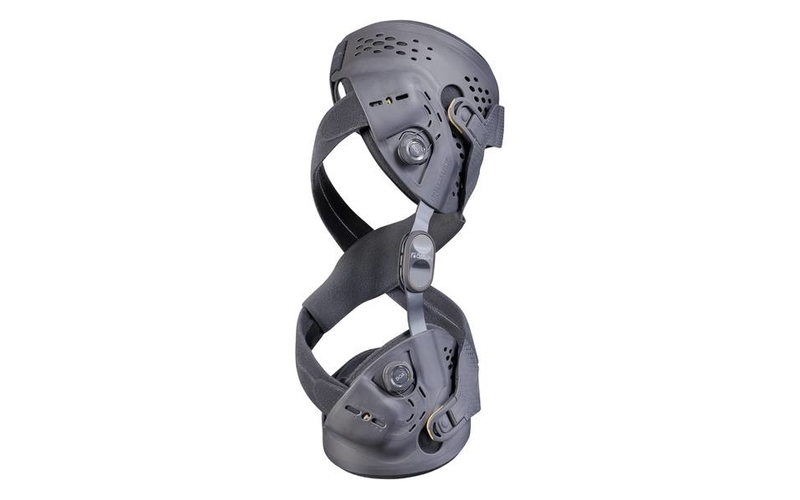

It is perhaps a common misconception among clinicians that knee bracing weakens muscles and is often a reason some are reluctant to brace patients long-term.
Professor Michael Callaghan PhD, MPhil, MCSP, Professor of Clinical Physiotherapy at Manchester Metropolitan University has negated this myth through his study “The Effect of Knee Braces on Quadriceps Strength and Inhibition in Subjects With Patellofemoral Osteoarthritis” and found that in some cases the quadricep muscle can get stronger when the knee is braced.
“Braces do not make your muscles weaker but in fact make them slightly stronger. There is less inhibition in the muscles, so you recruit more motor units”
At Össur we are focused on providing evidence-based solutions when designing and manufacturing our products and were fortunate to have the opportunity to hear directly from Prof Michael Callaghan about his research. At the cutting edge of osteoarthritis research through both Research into Osteoarthritis Manchester (ROAM Group) and Principal Investigator for the NIHR funded Prop OA Trial, his findings were thought-provoking to say the least.
Q: How do you interpret the current mindset on bracing within the physio community, and where might that come from?
Mike: Bracing has a mixed set of views, among clinicians generally and physios specifically.
For ankle conditions which involve pain and instability, braces are looked upon favourably with a rationale for their prescription, recommendation and use. They are seen as both a cost effective and clinically effective option. There’s also the reputation as something that can be worn on a return to play, being less obtrusive and aesthetically more acceptable.
For the knee, the brace is more often looked at as an early rehab protection post injury or surgery and increasingly something for those with a more chronic problem; such as osteoarthritis. The designs of the brace (for example Lycra or a metal hinge style) are important considerations for the level of treatment adherence. It is possible that a reluctance to recommend bracing for chronic knee pain has something to do with their cost and availability within the NHS, rather than a weak scientific rationale.
Q: What has your research highlighted when it comes to bracing of the knee?
Mike: Firstly, our research has shown that knee bracing has a beneficial role to play in the treatment of painful knee OA. Secondly, bracing doesn’t have much in the way of detrimental effects, few skin problems or adverse events. It’s also now clearer the need to be specific about the choice of knee brace, as one type may not benefit all conditions. For example, patellofemoral bracing may not be helpful for medial compartment knee OA and vice versa.
Our research highlighted another important fact, that knee bracing does not make the quadriceps muscles weak, which has long been expounded as a reason for wearing braces for as short a time as possible. This should remove one reason why braces are looked up with some reservation. It also showed that bracing improves knee joint proprioception.
Q: What’s your opinion on physiotherapy in combination with bracing?
Mike: Well, no-one knows the answer to this yet with any real certainty, which is why the multi-centre HTA funded PROP-OA trial is taking place in the UK. We are investigating whether combining a brace with the usual care for knee OA (including physiotherapy modalities like exercise) is more beneficial for patients’ arthritic knee pain than not adding a brace.
On the face of it, having two treatment modalities (brace and exercise) sounds like a winning combination. There is little risk of an adverse event from either and both have a good rationale for their use independently. So logic dictates that the two together might be even better, but we won’t know this with certainty until the PROP-OA trial publishes its findings.
It was undoubtedly an insightful look at the role bracing can play moving forward, and we’re excited to see what other new discoveries Professor Callaghan and his colleagues uncover in their research.
Key Findings of the Study
The Effect of Knee Braces on Quadriceps Strength and Inhibition in Subjects With Patellofemoral Osteoarthritis
A flexible knee support worn for about 7 hours daily for at least 6 weeks neither decreased strength nor increased inhibition of the quadriceps muscles. In fact, the knee support modestly increased strength and reduced inhibition.
Clinicians can encourage individuals with PFJ OA pain to use a flexible knee support without concern of a deleterious effect on quadriceps strength or activation over a 12-week period.
more recommended stories
 ChatGPT Excels in Medical Summaries, Lacks Field-Specific Relevance
ChatGPT Excels in Medical Summaries, Lacks Field-Specific RelevanceIn a recent study published in.
 Study finds automated decision minimizes high-risk medicine combinations in ICU patients
Study finds automated decision minimizes high-risk medicine combinations in ICU patientsA multicenter study coordinated by Amsterdam.
 Study Discovers Connection Between Omicron Infection and Brain Structure Changes in Men
Study Discovers Connection Between Omicron Infection and Brain Structure Changes in MenA recent study in the JAMA.
 Advancing COPD Prognosis: Deep Learning Models
Advancing COPD Prognosis: Deep Learning ModelsResearchers conducted a meta-analysis in a.
 4 in 1 Test for Swine Flu, COVID-19, RSV, and Influenza
4 in 1 Test for Swine Flu, COVID-19, RSV, and InfluenzaIn the United Kingdom, the first.
 Innovative Zika Virus Defense: Needle-Free Vaccine Patch
Innovative Zika Virus Defense: Needle-Free Vaccine PatchTo protect individuals from the potentially.
 Social Media Impact on Mental Health Treatment
Social Media Impact on Mental Health TreatmentAccording to research, social media might.
 Unveiling the Impact of Whole Grain Consumption on Slowing Memory Decline in Black Populations
Unveiling the Impact of Whole Grain Consumption on Slowing Memory Decline in Black PopulationsConsuming a diet rich in whole.
 $1 Cancer Treatment: Engineered Bacteria Breakthrough
$1 Cancer Treatment: Engineered Bacteria BreakthroughWhat if a single one-dollar dose.
 Pfizer COVID Booster: Half-Dose, Reduced Side Effects
Pfizer COVID Booster: Half-Dose, Reduced Side EffectsIn a recent report in The.

Leave a Comment